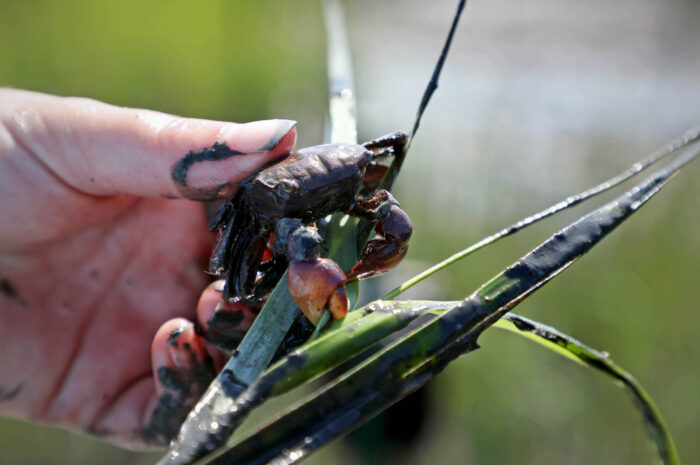Marsh crab
Sesarma reticulatum
The marsh crab is a small shore crab that lives in salt and brackish marshes in the middle and lower Chesapeake Bay.
This section shows one large critter image at a time. Use the thumbnails that follow to select a specific image to display here.

This gallery contains a grid of small thumbnails. Selecting a thumbnail will change the main image in the preceding section.
Appearance
The marsh crab has a small, square carapace (shell) that grows to one inch wide and varies in color from warm brown to dark olive. Its eyes are on stalks located at the front corners of its body. It has two teeth toward the front on either side of the shell and a notch along the middle of the shell. It has furry terminal joints on its first three walking legs.
Feeding
Marsh crabs eat the outermost leaves of marsh plants, especially cordgrass, and will sometimes prey upon fiddler crabs.
Predators
Black-crowned night herons are known predators.
Voice
Although the marsh crab does not produce vocal sounds, they do exhibit acoustic behavior. Male marsh craps produce a tapping sound to defend their burrows and to engage in mating with females. Males produce this sound by striking two of their legs together. These sounds typically consist of six to 29 taps, with a third of a second pause between taps.
Reproduction and life cycle
Little is known about the marsh crab life cycle. Females may carry 5,000 to 13,000 eggs at a time and breed up to five times in her lifetime. Their mating behavior includes a courtship tapping ritual, in which the males will tap the female and create drumming sounds with their walking feet. Mating ends with an indirect sperm transfer.
Did you know?
- The marsh crab is also known as the purple marsh crab, the square-backed marsh crab and the heavy marsh crab.
- Marsh crabs live communally within interconnected burrows in the mud. Burrows are 25 to 30 inches deep and usually filled with water. Burrow entrances are located near the high-tide line. Marsh crabs are most active at night.
- They have been linked to large losses of cordgrass in marshes on Cape Cod, Massachusetts, due to overeating.
Sources and additional information
- A Field Guide to the Atlantic Seashore by Kenneth L. Gosner
- Life in the Chesapeake Bay by Alice Jane Lippson and Robert L. Lippson
- Crustacea of New Jersey from the 1911 Annual Report of the New Jersey State Museum
- Animals of the Seashore by Horace G. Richards
- Beachcomber’s Guide to Gulf Coast Marine Life by Susan B. Rothschild
- Comparative Analysis of the Mating Strategies in Grapsid Crabs with Special References to the Intertidal Crabs Cyclograpsus Lavauxi and Helice Crassa (Decapoda: Grapsidae) from New Zealand by A. M. Brockerhoff and C. L. McLay
- Acoustic Behavior in the Purple Marsh Crab, Sesarma reticulatum Say (Decapoda, Grapsidae) by Richard E. Mulsta
- Sesarma reticulatum – Sea Life Base
